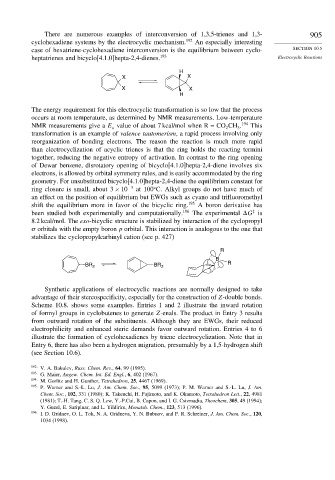Page 921 - Advanced Organic Chemistry Part A - Structure and Mechanisms, 5th ed (2007) - Carey _ Sundberg
P. 921
There are numerous examples of interconversion of 1,3,5-trienes and 1,3- 905
cyclohexadiene systems by the electrocyclic mechanism. 192 An especially interesting
case of hexatriene-cyclohexadiene interconversion is the equilibrium between cyclo- SECTION 10.5
heptatrienes and bicyclo[4.1.0]hepta-2,4-dienes. 193 Electrocyclic Reactions
H
X X
X X
H
The energy requirement for this electrocyclic transformation is so low that the process
occurs at room temperature, as determined by NMR measurements. Low-temperature
NMR measurements give a E value of about 7 kcal/mol whenR=CO CH . 194 This
a 2 3
transformation is an example of valence tautomerism, a rapid process involving only
reorganization of bonding electrons. The reason the reaction is much more rapid
than electrocyclization of acyclic trienes is that the ring holds the reacting termini
together, reducing the negative entropy of activation. In contrast to the ring opening
of Dewar benzene, disrotatory opening of bicyclo[4.1.0]hepta-2,4-diene involves six
electrons, is allowed by orbital symmetry rules, and is easily accommodated by the ring
geometry. For unsubstituted bicyclo[4.1.0]hepta-2,4-diene the equilibrium constant for
ring closure is small, about 3 × 10 −3 at 100 C. Alkyl groups do not have much of
an effect on the position of equilibrium but EWGs such as cyano and trifluoromethyl
shift the equilibrium more in favor of the bicyclic ring. 195 A boron derivative has
‡
been studied both experimentally and computationally. 196 The experimental G is
8.2 kcal/mol. The exo-bicyclic structure is stabilized by interaction of the cyclopropyl
orbitals with the empty boron p orbital. This interaction is analogous to the one that
stabilizes the cyclopropylcarbinyl cation (see p. 427)
R
B
BR 2 BR 2 R
Synthetic applications of electrocyclic reactions are normally designed to take
advantage of their stereospecificity, especially for the construction of Z-double bonds.
Scheme 10.8. shows some examples. Entries 1 and 2 illustrate the inward rotation
of formyl groups in cyclobutenes to generate Z-enals. The product in Entry 3 results
from outward rotation of the substituents. Although they are EWGs, their reduced
electrophilicity and enhanced steric demands favor outward rotation. Entries 4 to 6
illustrate the formation of cyclohexadienes by triene electrocyclization. Note that in
Entry 6, there has also been a hydrogen migration, presumably by a 1,5-hydrogen shift
(see Section 10.6).
192 V. A. Bakulev, Russ. Chem. Rev., 64, 99 (1995).
193
G. Maier, Angew. Chem. Int. Ed. Engl., 6, 402 (1967).
194 M. Gorlitz and H. Gunther, Tetrahedron, 25, 4467 (1969).
195 P. Warner and S.-L. Lu, J. Am. Chem. Soc., 95, 5099 (1973); P. M. Warner and S.-L. Lu, J. Am.
Chem. Soc., 102, 331 (1980); K. Takeuchi, H. Fujimoto, and K. Okamoto, Tetrahedron Lett., 22, 4981
(1981); T.-H. Tang, C. S. Q. Lew, Y.-P.Cui, B. Capon, and I. G. Csizmadia, Theochem, 305, 49 (1994);
Y. Guzel, E. Saripinar, and L. Yildirim, Monatsh. Chem., 123, 513 (1996).
196
I. D. Gridnev, O. L. Tok, N. A. Gridneva, Y. N. Bubnov, and P. R. Schreiner, J. Am. Chem. Soc., 120,
1034 (1998).

